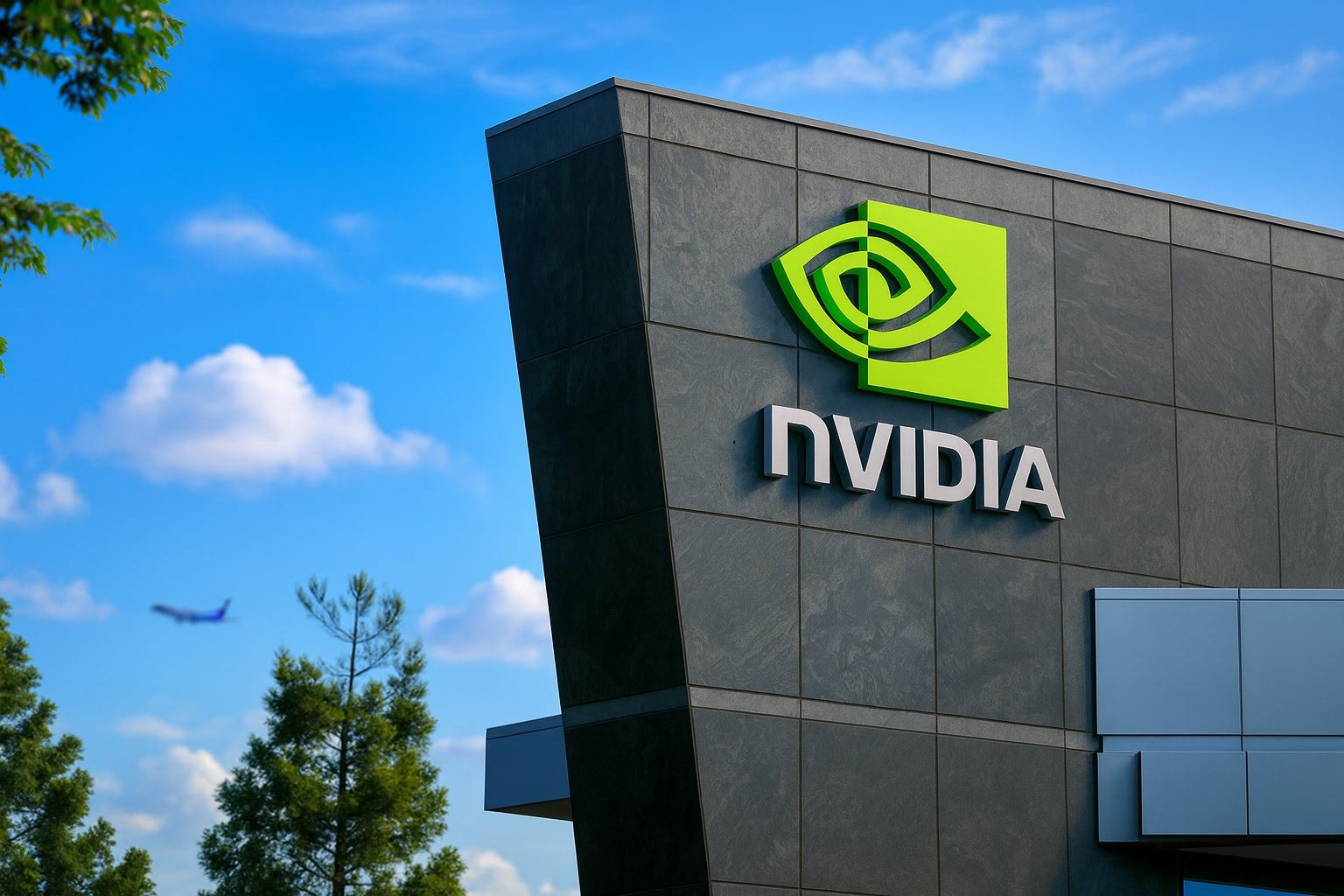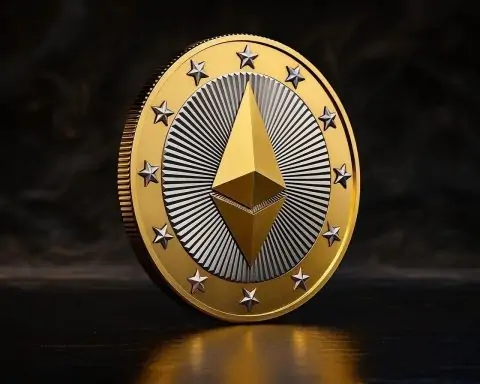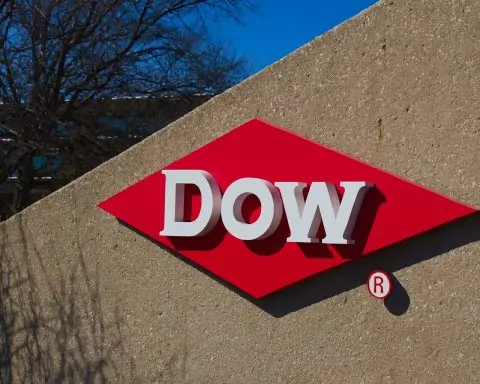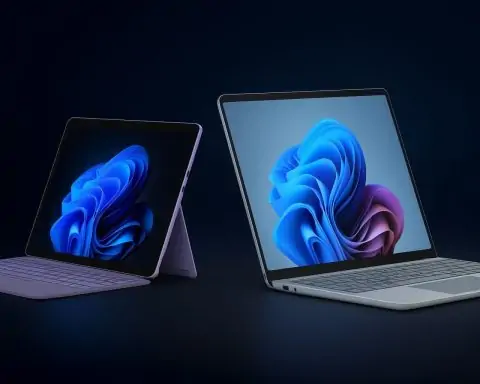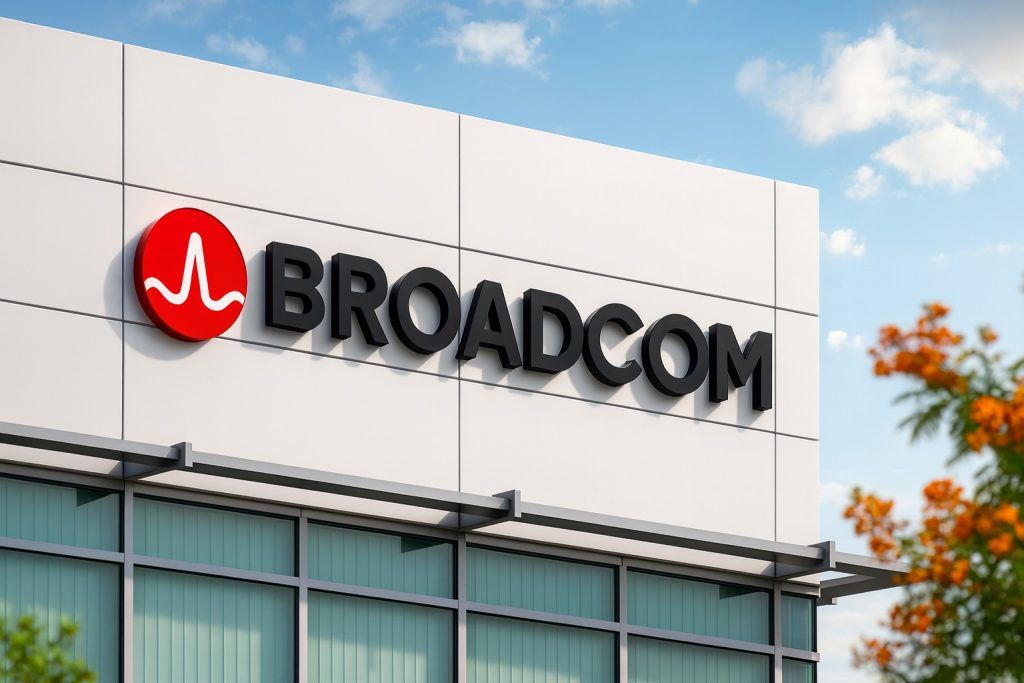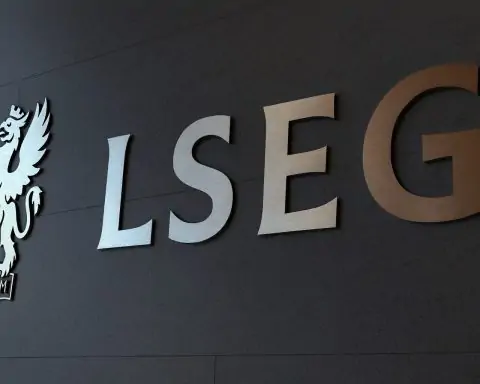- Record-Breaking Valuation: NVDA shares recently traded around $183 (Nasdaq:NVIDIA), with a market cap near $4.45 trillion [1] [2]. The stock peaked at $195.62 on Oct 9, 2025 [3]. Analysts’ 12-month consensus target is roughly $206–211 [4], with some bullish forecasts up to $250+ (Loop Capital, Cantor Fitzgerald) [5].
- Blistering Growth Metrics: In Q2 FY2026 (ended July 27, 2025) NVIDIA reported $46.7B revenue (+56% YoY) and $41.1B from data centers (+56% YoY) [6] [7]. GAAP gross margin was ~72.4%. NVIDIA guided Q3 revenue around $54B [8] [9] and analysts now expect full-FY2026 revenue north of $200B. These results leave NVDA trading at roughly 53× trailing P/E (∼33× forward) [10], far above chip-sector norms. (Valuation is widely debated.)
- AI Leadership & Mega Deals: NVIDIA is central to the AI infrastructure boom. It agreed to supply 10 gigawatts of GPU power to OpenAI and invest up to $100 billion in OpenAI’s next-gen AI models [11]. It also announced a $5B equity stake in Intel to jointly develop AI/PC chips. In the UK, NVIDIA is helping build “AI factories” – scaling up to 300,000 Grace/Blackwell GPUs globally (60,000 in the U.K.) and up to £11 billion in local AI infrastructure [12]. These partnerships (OpenAI, Microsoft, Amazon, Nscale, etc.) are cited as key growth drivers.
- Strong Gaming & PC Segment: NVIDIA’s gaming/AI-PC revenue jumped to $4.3B in Q2 FY2026 (+49% YoY) [13], as new GeForce RTX GPUs and AI-powered PCs drive sales. (By contrast, FY2025 gaming was ~$11.4B.) Cloud gaming and workstation GPUs also help. NVIDIA recently launched RTX 50-series GPUs (AI-upscaled graphics) and supports all major platforms. Gaming remains <10% of total revenue, but growth is resurgent.
- Automotive & Autonomous Growth: NVIDIA’s “automotive & robotics” revenue hit $586M in Q2 FY2026 (up 69% YoY) [14] after surpassing $1.7B for FY2025 [15]. Its DRIVE Orin/Thor chips power advanced driver-assistance systems. Major automakers (Toyota, Volkswagen, Mercedes, etc.) and startups (Aurora, Waymo, Zoox, Tesla’s Dojo, etc.) are NVIDIA DRIVE partners. In fact, NVIDIA expected the auto vertical to reach ~$5B by FY2026 [16]. CEO Jensen Huang has also pledged multibillion-dollar bets on self-driving: e.g. a planned $500M investment in UK startup Wayve [17] as part of a £2B UK AI commitment.
- Emerging Tech & Ecosystem: Beyond chips, NVIDIA leads in AI/graphics platforms. Its Omniverse 3D development suite and CUDA AI framework are widely adopted. The new NVLink “Fusion” interconnect lets partners like Qualcomm and Fujitsu build custom CPUs tightly coupled to NVIDIA GPUs [18]. NVIDIA also branches into robotics simulation [19] and quantum computing collaborations. Strategic R&D hubs (e.g. a UK AI-quantum center with Oxford Quantum) and developer training (UK MoUs) bolster its ecosystem.
- Analyst Outlook & Technicals: Consensus ratings are mostly “Buy/Overweight”: e.g. 41 Buys, 4 Holds out of 46 analysts [20]. Price targets average ~$211, with high forecasts near $250 [21]. Technically, NVDA is in a long-term uptrend (trading above 10/20-week EMAs [22]). Recent pullbacks left the 14-day RSI around 31.7 (slightly oversold) and MACD turned negative [23], suggesting caution short-term. Key support is near ~$182.7, resistance ~$190.4 [24].
Market Snapshot & Recent Performance
As of Oct. 13, 2025, NVIDIA (Nasdaq: NVDA) trades around $183 per share [25]. Reuters reports the latest trade at $183.16 (delayed) on Oct 13 [26]. (For context, NVDA hit a 52-week high of $195.62 on Oct 9, 2025 [27].) Its market capitalization is roughly $4.45 trillion (approximately 24.3B shares outstanding [28]). In one year NVDA is up ~38%, lifting it to the largest U.S. company by market cap.
Chart: NVIDIA (NVDA) stock climbed to a record ~$195 in early Oct 2025, then pulled back toward $183 [29] [30].
Consensus 12-month price targets cluster around $206–211 [31], reflecting ~10–15% upside. Some bulls see much more: e.g. Loop Capital raised its target to ~$250 [32], while Cantor Fitzgerald suggested $300 in 2030 (later). Valuation is stretched: NVDA’s trailing P/E is about 53× and forward P/E ~33× [33], well above sector peers (chipmakers often trade below 30×). This premium reflects expectations of continued hypergrowth from AI.
Financial Results & Forecasts
Q2 FY2026 Results: On Aug 27, 2025 NVIDIA reported stellar Q2 (fiscal Q2 = quarter ended July). Revenue was $46.7B (+56% vs. year-ago) [34] [35], led by datacenter sales. GAAP net income was $26.4B (+59% YoY) with EPS $1.08 (non-GAAP $1.05) [36]. Notably, Data Center revenue was $41.1B (+56% YoY) [37] [38], driven by AI training/inference GPUs. Gaming & AI-PC segment delivered $4.3B (+49%) [39], showing strong demand for new GeForce RTX cards and AI PCs. However, gaming had been weak earlier (e.g. Q4 FY2025 gaming was only $2.5B [40]). NVIDIA also announced it repurchased tens of billions and hiked its share-buyback authorization by $60B.
The outlook remains aggressive. For Q3 FY2026 management guided ~$54B revenue (±2%) [41] [42] and gross margin ~73%. Analysts had expected this, and some see upside. Markets now model FY2026 revenue exceeding $200B and EPS above $12. NVIDIA’s backlog and demand remain strong, as Jensen Huang noted “Blackwell Ultra [AI chip] ramping at full speed, demand is extraordinary” [43].
Valuation and Forecasts: NVDA’s price multiples reflect these earnings. As of Oct 2025, trailing GAAP P/E is ~53× and forward P/E ~33× [44]. Price/sales is near 27× and EV/FCF ~63×. Despite rich valuation, most Wall Street analysts remain bullish: 41 of 46 rate it Buy or Overweight [45]. MarketBeat’s consensus target is ~$211 [46] [47] (implying ~15% gain), with high forecasts $240–$250. For example, Loop Capital says NVDA “is the leader in AI/graphics” and models huge free cash flow, justifying lofty targets [48] [49].
Risks: Critics warn of stretched multiples. NVDA’s P/E is higher than other chip firms, inviting comparisons to a “bubble.” Concerns include the sustainability of such earnings growth, potential supply chain limits, and geopolitical risks (e.g. export curbs on AI chips to China). TS2 Tech notes that regulators and investors may scrutinize Nvidia’s “circular” AI deals (the network of deals among Nvidia, OpenAI, and Microsoft) [50]. The company’s massive energy use (data centers consume gigawatts of power) has also drawn attention [51]. Any slowdown in AI spending or a broader tech sell-off could trigger volatility.
Technical Analysis & Short-Term Outlook
From a trading perspective, NVDA’s chart in early Oct 2025 shows an uptrend but signs of short-term cooling. Weekly/multi-week charts remain bullish (price well above the 10- and 20-week moving averages) [52]. An ascending triangle pattern has formed with higher lows (recent supports around $182–187) [53]. Key near-term support is about $182.7 (major) and $177.0 (secondary) [54]; resistance sits near $187.6 and $190.4 (breakouts past 190–195 could test new highs) [55].
Short-term momentum indicators are mixed. As of Oct 10, NVDA’s 14-day RSI was only ~32 [56] (neutral-to-oversold territory) and MACD was negative [57], reflecting the recent pullback from all-time highs. On Oct 10, Investing.com showed a “Strong Sell” on short intervals (5m, 30m) but “Strong Buy” on weekly/monthly charts [58]. Thus, traders see a near-term correction or consolidation as likely. If NVDA holds above ~$180–182, the uptrend remains intact. A break below ~$177 could signal a deeper pullback (to $170–175 in a bearish case [59]).
Longer-term, many technical analysts view NVDA as still in an enduring bull market, given its dominant role in a secular AI/compute upcycle. Rising moving averages (200-day ~ $182 [60]) act as dynamic support. Weighing fundamentals, the consensus is that NVDA’s long-term trajectory is upward, even if short-term “profit-taking” occurs.
AI Leadership & Data-Center Dominance
NVIDIA is widely recognized as the king of AI chips. Its latest architecture, Blackwell (GB200/GB300 GPUs), is roughly 4× faster than the prior generation [61]. The company claims Blackwell’s “generational leap” drives extraordinary demand. Indeed, hyperscale AI customers (Microsoft Azure, Amazon AWS, Google Cloud, Oracle Cloud, CoreWeave, Lambda, etc.) are racing to secure NVIDIA’s GPUs. Forbes/Tech sites reported that Microsoft alone has deals for 100,000 NVDA GB300 GPUs (~$20B of hardware) through “neocloud” providers [62]. This underscores how crucial NVDA chips are to Big Tech’s AI initiatives.
NVIDIA’s server platform includes not only GPUs but also NVLink interconnect and the new Grace CPU (ARM-based). Notably, Nvidia announced NVLink Fusion (May 2025) allowing partners to build custom chipsets: e.g. Fujitsu and Qualcomm plan CPUs tightly integrated with NVIDIA GPUs [63]. This broadens Nvidia’s reach into custom AI server designs.
Competitive landscape in AI chips is heating up: AMD is pushing its new MI300 series GPUs. In October 2025, AMD struck a big deal to supply 6 gigawatts of MI300 chips to OpenAI (with an option for up to 10% equity) [64]. This echoes Nvidia’s OpenAI pact and makes AMD a stronger rival in the high-performance AI GPU market. Qualcomm and Intel (after their deal) may also accelerate their cloud offerings, though they currently rely on Nvidia for performance leadership.
Gaming, Pro Visualization & PCs
NVIDIA’s roots are in graphics, and its gaming segment remains important. Recent product launches (RTX 40/50 series GPUs) continue to drive its gaming and “AI PC” business. In Q2 FY2026, gaming/PC revenue was $4.3B [65], showing a strong 49% increase YoY – a sharp rebound from earlier in the year. NVIDIA’s GeForce GPUs dominate the PC gaming market, and its software stack (GeForce Experience, DLSS, ray-tracing) is widely adopted by game studios.
In the professional space, NVIDIA’s RTX workstations power design, visualization, and AI workloads. The Omniverse platform (virtual collaboration) is also gaining traction in media/entertainment and engineering. While traditional gaming consoles use other GPUs (Sony, Microsoft use AMD), NVIDIA benefits from PC and emerging cloud-gaming demand. Any weakness in consumer gaming (e.g. slower PC game sales) could dampen growth, but so far momentum remains high.
Automotive & Autonomous Driving
NVIDIA is increasingly a player in autonomous vehicles. Its core product is Drive AGX, an AI computer for cars that runs on-chip NVIDIA’s Orin/Thor SoCs and DriveOS software. Partners announced in 2025 include Toyota (VW’s next-gen EVs), Aurora (trucking), Continental (supplier), and more [66]. The January 2025 press release noted NVIDIA expects automotive revenue to hit $5 billion in FY2026 [67], up from roughly $1–2B now.
Financials support this: Q2 FY2026 auto & robotics segment was $586M (+69% YoY) [68]. In Q4 FY2025, auto was $570M (up 103% YoY) [69] – reflecting orders from EV/autonomous fleets. Many automakers (e.g. Mercedes, BMW, VW) and startups (Zoox, Nuro, Waymo) use NVIDIA’s platform for AI vision and planning. In “robotics,” NVIDIA’s Jetson modules (edge AI) and the Isaac simulator (for warehouse robots) add growth opportunities.
CEO Huang has touted huge potential in mobility: “Automotive will be one of the largest AI and robotics industries,” he said, highlighting NVIDIA’s two decades of safety-certified compute [70]. Meanwhile NVIDIA is investing in the ecosystem: e.g., partnering with UK-based Wayve (self-driving startup) with a potential $500M investment [71], and with Tech’s in-vehicle infotainment via Arm-based Drive Orin.
Strategic Initiatives & Partnerships
NVIDIA continues to forge strategic alliances. The OpenAI alliance is the headline: a non-voting, up-to-$100B partnership for next-gen AI infrastructure [72]. This cements NVIDIA chips as OpenAI’s core compute (GPT-5 and beyond). Concurrently, NVIDIA works with cloud giants: Microsoft and Azure consume vast numbers of GPUs (e.g. recently Microsoft announced a $33B commitment to AI data centers [73], much of which goes to NVIDIA), and Google/Oracle/Alibaba are major GPU buyers too.
NVIDIA’s Intel deal (announced Sep 18, 2025) is a paradigm shift in the chip world. NVIDIA agreed to buy $5B of Intel stock and jointly develop chips; Intel’s PC chip business is essentially “reset” to include NVIDIA IP. Analysts noted this as a huge validation of NVIDIA’s technology (and a lifeline for Intel). The shares of both jumped (Intel +23%). The combo suggests future PCs with NVIDIA GPUs and Intel CPUs, leveraging each company’s strengths.
Other notable partnerships: NVIDIA is collaborating with governments and academia on AI infrastructure. For example, a U.S.–UK tech initiative (starred by UK PM and Jensen Huang) spawned “AI factories” in the UK – essentially data centers packed with Blackwell GPUs [74]. Through this, NVIDIA and partners will install up to 120,000 Blackwell Ultra GPUs and £11B funding in UK data centers [75]. NVIDIA also joined forces with Oxford Quantum to build a quantum+GPU supercomputer in the UK [76]. These efforts help NVIDIA expand its global footprint and align with national technology strategies.
Competitors & Market Risks
NVIDIA’s biggest rivals include AMD, Intel, and Qualcomm (among others). AMD is its primary GPU competitor: AMD’s new MI300 GPUs compete in AI/data-center workloads. AMD’s surprise OpenAI deal (6GW GPUs for equity) [77] shows it’s catching up. In consumer GPUs, AMD’s Radeon cards and upcoming semi-custom chips for consoles keep competitive pressure on pricing and features. Qualcomm, known for mobile SoCs, is re-entering AI server chips; it has publicly teamed with NVIDIA (via NVLink Fusion [78]) to build custom AI CPUs, blurring competition lines. Intel, historically behind in GPUs, is now a partner – but still competes in CPUs and FPGAs for AI.
Regulatory and macro factors also pose risks. Export restrictions on AI chips to China could cap NVIDIA’s growth in a huge market. Power constraints (data centers require massive electricity) could slow expansion. Sentiment can swing quickly: for instance, when AMD’s OpenAI deal surfaced, NVDA shares dipped ~2% [79] on fears of pricing wars. Commentators warn of “FOMO” driving the rally – if AI hype cools, high valuations could mean steep corrections. The company’s own CEO acknowledged that “if order momentum stops or China gets tough,” it could impact results. Investors also watch NVIDIA’s exceptional gross margins (~70%) – sustained high demand must justify keeping them high, or competitors could push prices down.
Nevertheless, most analysts currently view these risks as manageable. The market is pricing in robust growth, and most say NVIDIA’s technology lead (especially in cutting-edge AI chips) gives it a durable advantage [80]. Earnings growth (weaker-than-expected now or not) will be closely watched; any miss could trigger a re-rating. For now, though, NVIDIA’s momentum has many believing the upward trend will continue.
Outlook
In summary, NVIDIA stands at the epicenter of the AI revolution. Its stock performance (soaring to multi-trillion-dollar valuation) reflects both unprecedented demand for its products and lofty investor expectations. Short-term indicators suggest the stock is in a correction phase (RSI oversold, recent pullback), but the medium-term trend is bullish given the heavy backlog of AI/data-center orders.
Wall Street’s consensus is that NVDA will keep growing earnings strongly: the average forecast calls for continuing 40–60%+ revenue growth in FY2026 [81] [82], largely from data centers and AI. If NVIDIA meets or beats guidance, price targets like $220–$250 could be reached by mid-2026. Longer-term (3–5 years), many strategists foresee NVIDIA dominating in AI compute – some even predict NVDA could hit $400+ by 2030 as AI expands across every industry.
Investors should watch the next earnings release (Nov 19, 2025) and guidance closely. Technically, a decisive break above ~$190–195 would signal new highs, whereas a drop below ~$177 would raise caution. Meanwhile, emerging developments (OpenAI model launches, new GPU architectures, global AI initiatives) will continue to move the stock. In any case, NVIDIA remains the marquee AI stock – “more of an AI pioneer than ever,” as Cramer said [83] – but also one trading under a microscope. Like all tech giants, it will need to deliver on sky-high expectations or face meaner questions about its price tag [84] [85].
Sources: Authoritative news, press releases and analysis reports were consulted, including NVIDIA’s own filings [86] [87], industry news (Reuters, CNBC, Bloomberg, etc.), and expert analyses [88]. Notably, TS2 Tech (ts2.tech) and Reuters provided key data points (Q2 results, AI deals) [89] [90]. All data is current as of Oct 13, 2025.
References
1. www.reuters.com, 2. www.tradingview.com, 3. www.tradingview.com, 4. ts2.tech, 5. ts2.tech, 6. ts2.tech, 7. nvidianews.nvidia.com, 8. ts2.tech, 9. nvidianews.nvidia.com, 10. ts2.tech, 11. www.reuters.com, 12. nvidianews.nvidia.com, 13. nvidianews.nvidia.com, 14. nvidianews.nvidia.com, 15. nvidianews.nvidia.com, 16. investor.nvidia.com, 17. techcrunch.com, 18. nvidianews.nvidia.com, 19. nvidianews.nvidia.com, 20. ts2.tech, 21. ts2.tech, 22. copygram.app, 23. www.investing.com, 24. copygram.app, 25. www.reuters.com, 26. www.reuters.com, 27. www.tradingview.com, 28. ts2.tech, 29. www.tradingview.com, 30. www.reuters.com, 31. ts2.tech, 32. ts2.tech, 33. ts2.tech, 34. ts2.tech, 35. nvidianews.nvidia.com, 36. nvidianews.nvidia.com, 37. ts2.tech, 38. nvidianews.nvidia.com, 39. nvidianews.nvidia.com, 40. nvidianews.nvidia.com, 41. ts2.tech, 42. nvidianews.nvidia.com, 43. nvidianews.nvidia.com, 44. ts2.tech, 45. ts2.tech, 46. ts2.tech, 47. ts2.tech, 48. ts2.tech, 49. ts2.tech, 50. ts2.tech, 51. ts2.tech, 52. copygram.app, 53. copygram.app, 54. copygram.app, 55. copygram.app, 56. www.investing.com, 57. www.investing.com, 58. www.investing.com, 59. copygram.app, 60. www.investing.com, 61. nvidianews.nvidia.com, 62. www.tomshardware.com, 63. nvidianews.nvidia.com, 64. ts2.tech, 65. nvidianews.nvidia.com, 66. investor.nvidia.com, 67. investor.nvidia.com, 68. nvidianews.nvidia.com, 69. nvidianews.nvidia.com, 70. investor.nvidia.com, 71. techcrunch.com, 72. www.reuters.com, 73. www.tomshardware.com, 74. nvidianews.nvidia.com, 75. nvidianews.nvidia.com, 76. nvidianews.nvidia.com, 77. ts2.tech, 78. nvidianews.nvidia.com, 79. ts2.tech, 80. ts2.tech, 81. ts2.tech, 82. ts2.tech, 83. finviz.com, 84. ts2.tech, 85. www.investing.com, 86. nvidianews.nvidia.com, 87. nvidianews.nvidia.com, 88. ts2.tech, 89. ts2.tech, 90. www.reuters.com
